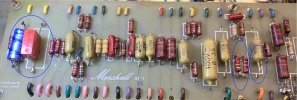Ken Bob
Active Member
Hello again Marshall-mates!
Posting here again regarding the '73 UK-spec Super Lead I recently acquired. The amp was, prior to my ownership, restored to the original circuit, as best as I can tell, and not all that much was done aside from new V1 bypass caps, and a few minor components here and there. It works great, and is a monstrous, aggressive beast. The only issue I seem to be having is I'm noticing a harsh, ratty kind of distortion artifact on low notes, which increases/decreases with guitar volume. I've owned quite a few Marshalls over the years, but haven't heard this exact thing before. It seems to be present on both I and II channels, but obviously is way more apparent on the I channel. The amp cleans up just fine with guitar vol rollback (clean being relative, as the amp is super gainy and hairy past "2"). Wondering if any of you super-knowledgeable gurus can help diagnose what's going on here?
PT, OT, and choke are original. Power tubes are new, and I biased them myself: @120 VAC, plate volts 499, 34 mA. Tube sockets were cleaned and tensioned a couple weeks ago. Filter caps are newer-ish ARS, though not sure exact age. No hum or other weird noises. No caps are swelled or leaking. Heaters are 6.31 VAC. Swapping preamp tubes doesn't change the issue. I've tried different speaker cabs with no change. Rolling back the Presence does lessen the issue somewhat, but does not eliminate it. NFB appears to be the stock 100k/4-ohm, and the presence cap appears to be an unusual factory-original 1.0mF (asked about this in a previous post). Bright cap is a non-original 1000pf (though I kinda like it). While scanning the forums here for any related info, I did come across a prior discussion regarding oscillations that recommended watching the idle current while rolling the knobs up with no input to the amp - I tried this this morning using a bias probe, and there is no change in the idle current whether everything is on 10 or 0. At this point, I'm kind of out of ideas.


Here's a couple recorded clips. Excuse my rubbish noodling - I'm just trying to get various sounds out of the amp. But both clips capture the harsh distortion thing happening in the last 40 seconds of each clip. It's very apparent in the room - most especially on the low notes and chords. Hope it comes across.
Sincere thanks to one and all for any helpful insight! So many knowledgeable folks here, and I always learn a lot from you!!
-Ken
Posting here again regarding the '73 UK-spec Super Lead I recently acquired. The amp was, prior to my ownership, restored to the original circuit, as best as I can tell, and not all that much was done aside from new V1 bypass caps, and a few minor components here and there. It works great, and is a monstrous, aggressive beast. The only issue I seem to be having is I'm noticing a harsh, ratty kind of distortion artifact on low notes, which increases/decreases with guitar volume. I've owned quite a few Marshalls over the years, but haven't heard this exact thing before. It seems to be present on both I and II channels, but obviously is way more apparent on the I channel. The amp cleans up just fine with guitar vol rollback (clean being relative, as the amp is super gainy and hairy past "2"). Wondering if any of you super-knowledgeable gurus can help diagnose what's going on here?
PT, OT, and choke are original. Power tubes are new, and I biased them myself: @120 VAC, plate volts 499, 34 mA. Tube sockets were cleaned and tensioned a couple weeks ago. Filter caps are newer-ish ARS, though not sure exact age. No hum or other weird noises. No caps are swelled or leaking. Heaters are 6.31 VAC. Swapping preamp tubes doesn't change the issue. I've tried different speaker cabs with no change. Rolling back the Presence does lessen the issue somewhat, but does not eliminate it. NFB appears to be the stock 100k/4-ohm, and the presence cap appears to be an unusual factory-original 1.0mF (asked about this in a previous post). Bright cap is a non-original 1000pf (though I kinda like it). While scanning the forums here for any related info, I did come across a prior discussion regarding oscillations that recommended watching the idle current while rolling the knobs up with no input to the amp - I tried this this morning using a bias probe, and there is no change in the idle current whether everything is on 10 or 0. At this point, I'm kind of out of ideas.


Here's a couple recorded clips. Excuse my rubbish noodling - I'm just trying to get various sounds out of the amp. But both clips capture the harsh distortion thing happening in the last 40 seconds of each clip. It's very apparent in the room - most especially on the low notes and chords. Hope it comes across.
Sincere thanks to one and all for any helpful insight! So many knowledgeable folks here, and I always learn a lot from you!!
-Ken

